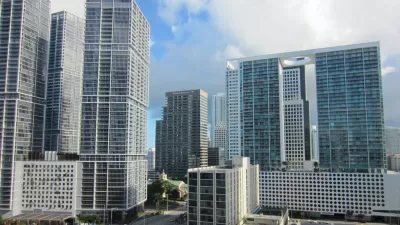Alastair Gordon lambasts Miami's high-end architectural extremes. A horizontal, nature-inspired urbanism might better address contradictions between breezy luxury and inland poverty.

In part a criticism of faddish architecture through the lens of Miami, Gordon's article envisions a more equitable and sustainable model for the Florida city. In spite of widespread hype and celebrity status for "starchitects," the luxury high-rise model remains "surprisingly formulaic."
Miami’s abodes for the ultra-rich exhibit a designed disconnect with the rest of the city. As Gordon puts it, "Early skyscrapers in New York and Chicago drew energy up from the earth with brooding setbacks, finials, gargoyles and Faustian shadows. In contrast, the recent high-rises of Miami appear to dangle downwards, hardly touching the earth at all."
Gordon argues that despite isolated overtures toward social urbanism, the predominant architectural mode promotes isolation and escape. He points to a different way, exemplified by the Perez Art Museum and Stiltsville: "low-lying structures that feed and filter the urban environment while adapting to climatic uncertainties, flood or drought."
Inspired by Florida's water-friendly mangroves and banyans, this kind of horizontal urban design may help the city address its significant climate risks and social inequality.
FULL STORY: In excess-driven Miami, design gurus should take a few lessons from nature

Maui's Vacation Rental Debate Turns Ugly
Verbal attacks, misinformation campaigns and fistfights plague a high-stakes debate to convert thousands of vacation rentals into long-term housing.

Planetizen Federal Action Tracker
A weekly monitor of how Trump’s orders and actions are impacting planners and planning in America.

San Francisco Suspends Traffic Calming Amidst Record Deaths
Citing “a challenging fiscal landscape,” the city will cease the program on the heels of 42 traffic deaths, including 24 pedestrians.

Defunct Pittsburgh Power Plant to Become Residential Tower
A decommissioned steam heat plant will be redeveloped into almost 100 affordable housing units.

Trump Prompts Restructuring of Transportation Research Board in “Unprecedented Overreach”
The TRB has eliminated more than half of its committees including those focused on climate, equity, and cities.

Amtrak Rolls Out New Orleans to Alabama “Mardi Gras” Train
The new service will operate morning and evening departures between Mobile and New Orleans.
Urban Design for Planners 1: Software Tools
This six-course series explores essential urban design concepts using open source software and equips planners with the tools they need to participate fully in the urban design process.
Planning for Universal Design
Learn the tools for implementing Universal Design in planning regulations.
Heyer Gruel & Associates PA
JM Goldson LLC
Custer County Colorado
City of Camden Redevelopment Agency
City of Astoria
Transportation Research & Education Center (TREC) at Portland State University
Jefferson Parish Government
Camden Redevelopment Agency
City of Claremont


























